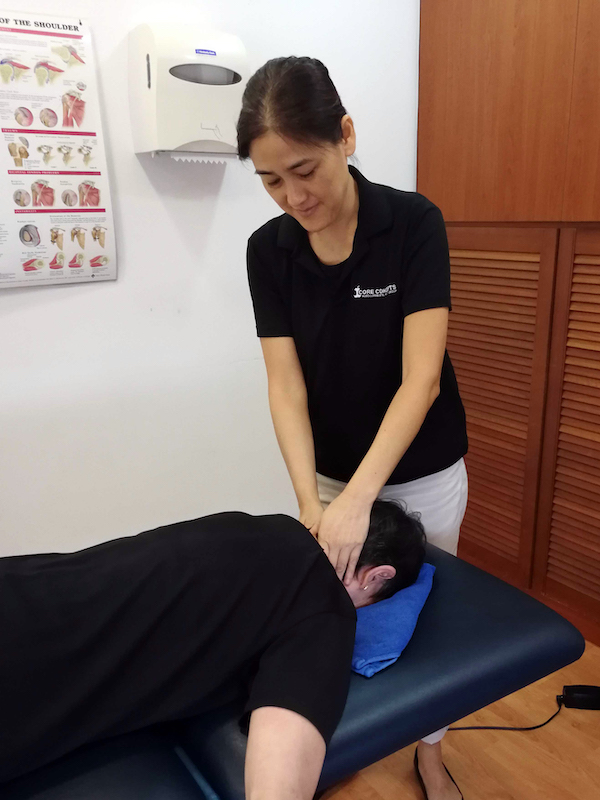Living life pain-free
Lim See Bee had an injury and her active life took a tumble. With the help of a physiotherapist, she is slowly getting her life back.
Lim See Bee was leading an active life, hitting the gym on a daily basis but an injury set her back. The 58-year-old artist and architect shared that the result was some pain, numbness and tingling in her left leg.
“After my injury, I lived through the pain for two weeks before finally consulting a general practitioner (GP). By that point, I couldn’t run anymore and couldn’t sit for more than a few minutes. The pain was so intense that I couldn’t sleep as well,” shared See Bee.
Her GP prescribed a course of medication for three months, which did alleviate the pain by quite a bit but she still felt numbness in her foot and toes. “The numbness even caused me to develop an unnatural gait, and consequently, persistent knee pain,” she said.
It was then that the GP referred her to Core Concepts for physiotherapy treatment, which she ended up going in May of this year and her first time ever going to physiotherapy. Sharing her experience, See Bee said, “The first physiotherapy session centered around discovery. My physiotherapist took me through a comprehensive assessment that identified the root cause of my pain. She explained what had gone wrong in the musculoskeletal areas that resulted in my pain – this was something that was never made known to me by doctors. The discovery process helped to clear a lot of doubts that I had prior to stepping into the session.”
Next, See Bee embarked on a treatment plan to strengthen her muscles, so that she could carry out normal daily functions without pain, with the goal to eventually be able to jog again. Apart from leg strengthening exercises like squats and split squats, there were core and upper limb exercises like rows and presses.
Since then she has seen progress. She said, “My current treatment goal is to walk for 30 minutes. After starting the exercise portion of the treatment two-and-a-half months ago, I’ve achieved 20 minutes of walking and can now manage squatting to pick up items from lower shelves, and climbing stairs pain-free. We’re now working on improving my ability to absorb shock with exercises like lunges and split hops, and incorporating the core and upper limb exercises.”
But it wasn’t just physical recovery for See Bee, she also saw improvement in her mental health. “Before seeking treatment, I was fearful and anxious, especially as I had incomplete knowledge around what caused the tingling, numbness and persistent pain I experienced. Furthermore, the deluge of conflicting information on the Internet only confused me further.
“Working with the physiotherapist has given me a lot of clarity and mental strength. Now, I can power through a more normal gait when I walk. She has helped me to understand what’s happening in my body. I’m now able to tackle day-to-day activities with renewed confidence,” she said. On average, she visits the clinic two to three times a week and her sessions range from S$135 to S$150, before medical subsidies and insurance coverage.
Sylvia Ho, senior principal physiotherapist at Core Concepts, said, “With ageing, seniors become more susceptible to issues with osteoporosis, reduced muscle strength, mobility and balance. This makes them more vulnerable to musculoskeletal injuries. Many seniors may also feel fearful of falling or over-exerting themselves. Physiotherapy can restore or increase a patient’s strength, range of motion, flexibility and coordination. It can also reduce pain for those suffering from musculoskeletal issues.
“Many chronic diseases and heart diseases stem from cholesterol issues, hypertension, immobility and the general lack of exercise where there is a compromise in cardiac functions. Physiotherapists prescribe exercises to strengthen the heart as well as the lungs,” she said.
Ho also shared that those with diabetes can also be helped with physiotherapy. “We prescribe specific exercises to enhance their mobility and overall treatment. With diabetes, apart from general fitness conditioning, we try to get the body to reduce glucose intolerance with resistance and aerobic exercises. We also prescribe high-intensity progressive resistance training, which is effective in regulating the blood glucose levels of older patients with Type-2 diabetes when combined with moderate weight loss.”
Beyond the physical body, she also shared that physiotherapy can also address mental barriers that hold seniors back from being their best selves. “For example, we’ve once treated a patient with a fear of bending. By helping him to analyse his fears, we found that it originated from his father’s injury, which was caused by lifting in a bent position. We addressed his fear by counselling and empowered the client with the right knowledge so he can manage his health in the right way.”


0 Comments